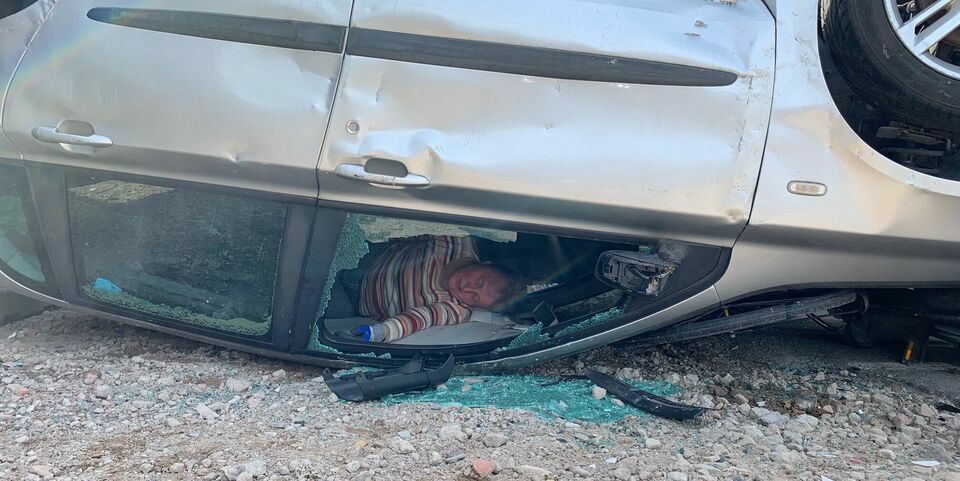Fire department VRBZO trains on the campus due to the war
On Tuesday, 12 April, one of the training days of the Veiligheidsregio Brabant Zuidoost (VRBZO) [Safety region southeast Brabant] took place on the campus. A group of firefighters practiced here because their actual location was not available due to the war in Ukraine. The terrain of the TU/e turns out to be perfectly suited for all kinds of creative accidents. In fact, it is so well suited that other corps want to join in.
The professional firefighters are on the campus the entire day to practice four different scenarios, all focused on technical assistance. You can think of scenarios such as freeing victims from a vehicle in a car accident. “The firefighters were supposed to practice at the MOB-complex in Mariahout," says TU/e-lieutenant Tim Schippers. "But due to the war in Ukraine, that complex had to serve as a backup location for the army. The practices need to go on, and it requires quite a lot from the location. We have been working a lot with the fire department Southeast Brabant, and our terrain offers a lot of possibilities, so we would like to help them now.” Bram Daams and Nick Saffrie from VRBZO are supervising the exercises today. Saffrie: “We come up with the scenarios and set them out. Then, we observe and see how everything goes. A total of 130 people will be practicing on the campus.”
Accidents
The practice days are made up of theme days that all concern extinguishing fires, technical assistance, or handling hazardous substances. On the day that the Cursor editor follows along, the focus is on technical assistance. “Different scenarios have been set out on the entire campus," says Schippers. In this case, there are scrap cars that are used for the exercises. Oftentimes, bicycles are set out as well, and mannequins are placed to represent victims. An A4 is taped to the head of the mannequin with information about the mock condition of the victim. “It helps the lieutenant decide which tasks are necessary," says supervisor Nick Saffrie. When the exercise takes place, there are so-called lotus victims as well who have been trained to mimic victims.
Behind Fenix, we come across a car accident with five wounded, one of which is a cyclist who ended up under two cars. The lieutenant calmly tells the other firefighters what needs to be done, which victims need to be removed first, and how the rescue should be executed. There is not a trace of discussion like you might expect on the work floor when the manager is handing out orders. For now, the word of the lieutenant is law. It is crucial that during the exercise, everything is coordinated and calm. Whether the lieutenant’s decision was right or not can be discussed afterward; after all, everything will be evaluated.
Back to the accident simulation: the victims need to be rescued from under the cars. Interestingly, little interaction is sought with the victims, something other responders such as EROs and ambulance staff would do. Saffrie confirms that entire conversations are rarely held, "only when a victim initiates contact with a firefighter. We are more concerned with the technical part of the job."
Once the victims have been freed from their plight at the Fenix traffic accident, the team can move on to the hangar at the site of the former dome. In the hanger, a large highway chain collision has been simulated. The room is filled with smoke, and multiple cars are piled atop each other. There are four victims, one of which is our Cursor editor. Wearing heavy-duty masks, the rescuers move through the hangar with utmost focus that would be the envy of an average editor-in-chief. These fire fighters are truly unshakable.
The exercises are taken very seriously. The fire department needs to practice these operations regularly to remain trained. "We notice that it attracts a lot of attention," says Schippers as he takes Cursor to the bicycle storage room of Vertigo. "Just imagine arriving at work and finding a mannequin like that here under a trailer; that raises questions." The fact that the car is parked at Vertigo is no coincidence. Schippers compliments Tom van Aarle, the facility manager at Vertigo: "without him, it would have never been possible to create so many scenarios in such a short time." Van Aarle himself is active at the fire department in Son & Breugel as a volunteer: "The colleagues there now also want to run these scenarios," he says, laughing. "Let's see if that's possible."
Competition on the campus
These practice days are not open to the public, but the ABWC-competitions are. At the competitions, similar exercises can be seen that are also linked to themes of fire, technical assistance, and hazardous substances. On 7 May, a competition will take place on the TU/e campus that is open to the public. Teams from the entire region will participate. The event has been organized on behalf of and by the VRBZO women's team, which includes TU/e firefighter Janneke Zeebregts. The winning team will receive a trophy, something that is not new for the TU/e-fire department, as is evidenced by the string of trophies at the fire station:








Discussion